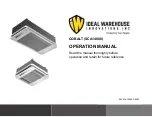
Page 12
Refer to the following diagram to ensure proper distance from walls and ceiling:
Indoor Unit
Installation
Fig. 3.1-b
12cm (4.75in)
or more
2.3m (90.55in) or more
12cm (4.75in)
or more
15cm (5.9in) or more
Step 2: Attach mounting plate to wall
The mounting plate is the device on which you
will mount the indoor unit.
1. Remove the screw that attaches the mounting
plate to the back of the indoor unit.
2. Place the mounting plate against the wall
in a location that meets the standards in
the
Select Installation Location
step.
(See
Mounting Plate Dimensions
for detailed
information on mounting plate sizes.)
3. Drill holes for mounting screws in places that:
•
have studs and can support the weight of
the unit
•
correspond to screw holes in the mounting
plate
4. Secure the mounting plate to the wall with
the screws provided.
5. Make sure that mounting plate is flat against
the wall.
NOTE FOR CONCRETE OR BRICK WALLS:
If the wall is made of brick, concrete, or similar
material, drill 5mm-diameter (0.2in-diameter)
holes in the wall and insert the sleeve anchors
provided. Then secure the mounting plate to
the wall by tightening the screws directly into
the clip anchors.
Step 3: Drill wall hole for connective piping
You must drill a hole in the wall for refrigerant
piping, the drainage pipe, and the signal cable
that will connect the indoor and outdoor units.
1. Determine the location of the wall hole based
on the position of the mounting plate. Refer
to
Mounting Plate Dimensions
on the
next page to help you determine the optimal
position. The wall hole should have a 65mm
(2.5in) diameter at least, and at a slightly
lower angle to facilitate drainage.
2.
3. Place the protective wall cuff in the hole. This
protects the edges of the hole and will help
seal it when you finish the installation process.
CAUTION
When drilling the wall hole, make sure to
avoid wires, plumbing, and other sensitive
components.
Using a 65mm (2.5in) or 90mm(3.54in)
(depending on models )core drill, drill a
hole in the wall. Make sure that the hole
is drilled at a slight downward angle, so
that the outdoor end of the hole is lower
than the indoor end by about 5mm to 7mm
(0.2-0.27in). This will ensure proper water
drainage. (See
Fig. 3.2
)
Summary of Contents for HKD
Page 134: ......
Page 135: ......
Page 137: ......
Page 138: ......
Page 139: ......
Page 140: ......
Page 141: ......
Page 142: ......
Page 143: ......
Page 144: ......
Page 145: ......
Page 146: ......
Page 147: ......
Page 148: ......
Page 149: ......
Page 150: ......
Page 151: ......
Page 152: ......
Page 153: ......
Page 154: ......
Page 155: ......
Page 156: ......
Page 157: ......
Page 158: ......
Page 159: ......
Page 160: ......
Page 161: ......
Page 162: ......
Page 163: ......
Page 167: ......
Page 168: ......
Page 171: ......
Page 172: ......
Page 174: ......
Page 175: ......
Page 176: ......
Page 177: ......
Page 178: ......
Page 179: ......
Page 180: ......
Page 181: ......
Page 182: ......
Page 183: ......
Page 184: ......
Page 185: ......
Page 189: ......
Page 190: ......
Page 191: ......
Page 192: ......
Page 194: ......
Page 195: ......
Page 196: ......
Page 197: ......














































